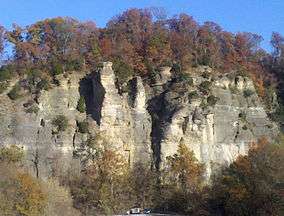Clear Springs Wilderness
The Clear Springs Wilderness is a 4,730-acre (19.1 km²) parcel of land listed as a Wilderness Area of the United States. It contains the LaRue-Pine Hills Ecological Area, a National Natural Landmark noted for a large and diverse population of snakes.[1][2]
| Clear Springs Wilderness | |
|---|---|
IUCN category Ib (wilderness area) | |
 | |
 | |
| Location | Jackson County, Illinois, USA |
| Nearest city | Wolf Lake, IL |
| Coordinates | 37°35′N 89°25′W |
| Area | 4,730 acres (1,910 ha) |
| Established | 1990 |
| Governing body | U.S. Forest Service |
The wilderness is located within the Shawnee National Forest in southwestern Jackson County and northwestern Union County is the U.S. state of Illinois. The nearest town of any size is Wolf Lake, Illinois.[3]
Second-growth wilderness
The steep hills of the Clear Springs Wilderness are drained by many limestone springs, including Clear Springs, which drains into Hutchins Creek and then into Clear Creek.[3]
As with other wilderness areas within Shawnee National Forest, the Clear Springs Wilderness is made up of second-growth forested areas that were used, until the land acquisitions of the 1930s, as agriculture land. The steep eastern bluffs over the Big Muddy River were not good ground for agriculture. Most of the soil that used to be here has eroded into the Big Muddy's bed. Firewood was cut here, and farmers may have tried to use the region's well-watered, temperate climate for livestock grazing. Shawnee National Forest was created in 1939, and in 1990, the Illinois Wilderness Act set aside seven separate parcels of land within this National Forest as relatively small wilderness areas. The Clear Springs Wilderness, one of these parcels, is a roadless parcel of land within the national forest.[3]
The Clear Springs Wilderness borders the Bald Knob Wilderness, which lies to the south and east. The two wilderness parcels are separated by Hutchins Creek. Both wildernesses are managed by the United States Forest Service and are served by the forest's River to River Trail.[3][4]
From Wolf Lake, visitors may choose to drive north approximately 3.5 miles (5.5 km) on Illinois Route 3 until they get to the ghost town of LaRue, Illinois. From here an eastward local road, by means of a series of hairpin turns, provides motor vehicle access up the bluff to the edge of the wilderness area, which is perched atop the bluff. The local road is officially called LaRue Road, but is widely and unofficially called Snake Road because of the large quantities of snakes that use the road for their seasonal migrations.[1] For this reason the access road is often closed to motorized traffic. Snake species found here include the black rat, common king, rough green, western ribbon, the venomous copperhead, and the venomous cottonmouth.[5]
The LaRue-Pine Hills zone has also been listed as an Important Bird Area of Illinois.[6]
References
- Cartmell, Nichole (May 16, 2018). "35 native snake species call this southern Illinois natural area home". KFVS-TV. Cape Girardeau, Mo. Retrieved May 16, 2018.
- "National Natural Landmarks - National Natural Landmarks (U.S. National Park Service)". www.nps.gov. Retrieved 2019-03-21.
Year designated: 1974
- "Shawnee National Forest: Wilderness". United States Forest Service. Retrieved 2009-04-06.
- Zyznieuski, Walt (2009-05-06). "Exploring the Shawnee National Forest". Illinois Times. Retrieved 2009-05-09.
- Joe McFarland, "A Visit to Pine Hills", Outdoor Illinois XVI:4 (April 2008), page 11.
- "Illinois Important Bird Areas". Chicago Wilderness. Archived from the original on 2011-07-17. Retrieved 2010-02-16.